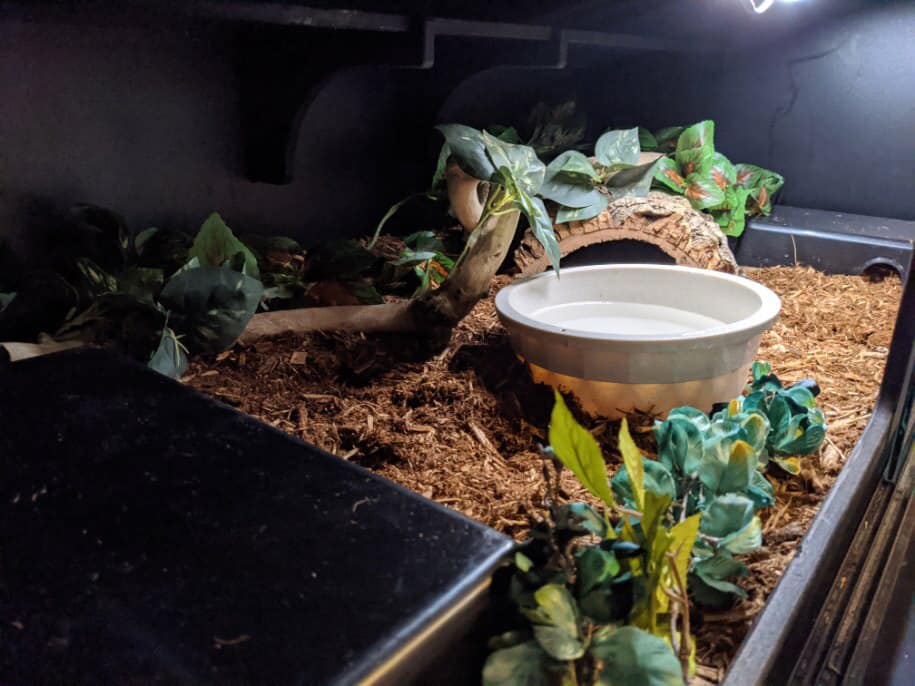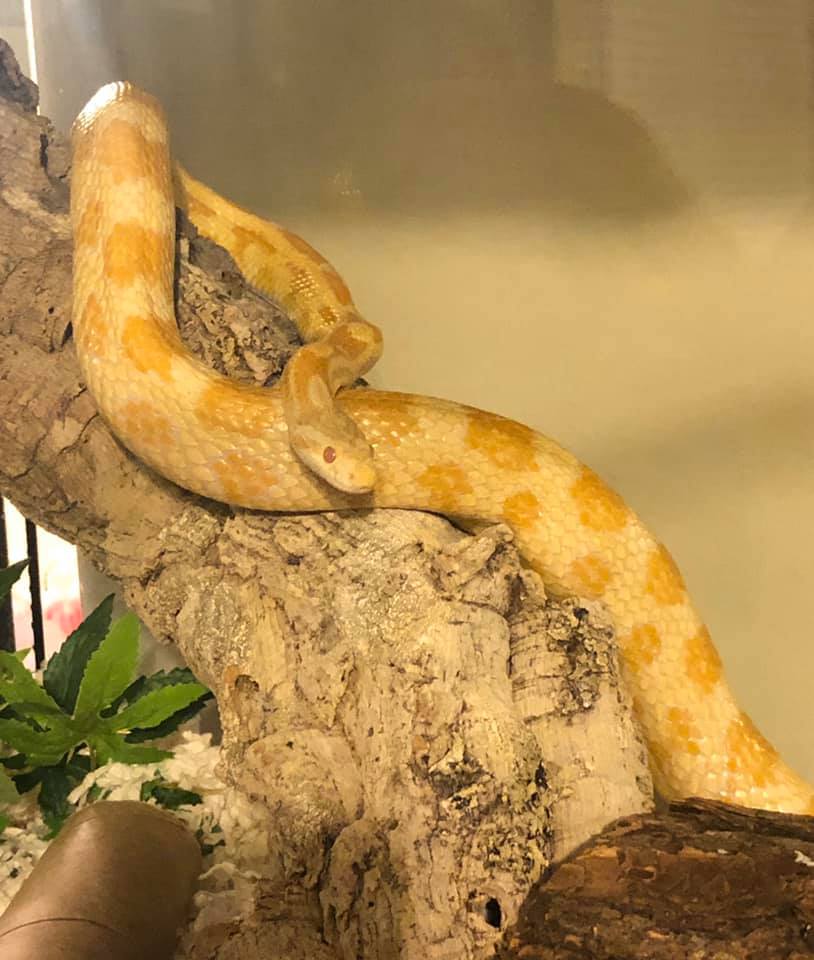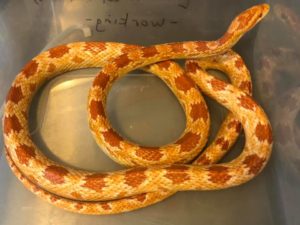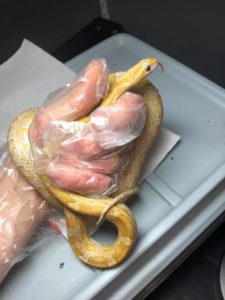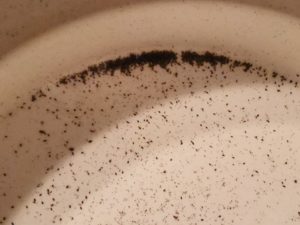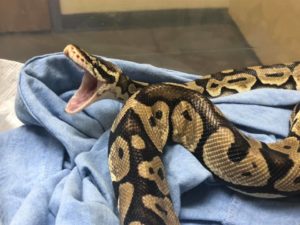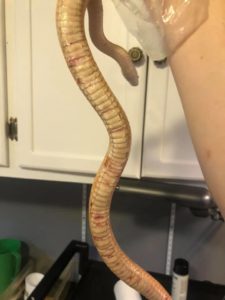CORN SNAKE CARE GUIDE
Species name: Pantherophis guttatus guttatus
Lifespan: 15-20 years
Origin: Southeastern United States
Adult size: 3-5 feet
Caging
Our minimum recommended size for an adult corn snake is a 50 gallon breeder tank, or a 36” x 18” x 18” enclosure. A 4’ x 2’ x 2’ is even better. Babies can be started off in 10 gallon tanks and moved up as they grow. Appropriate caging types include sliding-lid or front-opening aquariums, PVC or wooden enclosures, or even large plastic bin enclosures as long as they meet the space requirements. Corn snakes are escape artists so make sure your enclosure is very secure.
Decor
The most important piece of decor for a corn snake is a good hide! Choose a hide that has one small opening so that the snake can feel secure and hidden. We like the plain black plastic hides from Pangea, but other more naturalistic hides work as well. Offer your snake at least 2 hides, one on each side of the enclosure. Other good enrichment items include cork bark, branches, and foliage to hide in. Make sure your corn snake has at least 2 hide boxes, one on the cool side and one on the warm side.
Substrate
Because corn snakes are a low-humidity species, they can thrive in many different types of substrates. Paper towels are good for animals in quarantine or snakes with health issues. Healthy, established animals should be given a substrate that is at least 1-2” thick to allow for burrowing. Aspen shavings, ReptiChip, or cypress mulch (Forest Floor) are all easy basic substrates that corn snakes do well in. We don’t recommend using Eco Earth by itself, as it can get dusty when dry. You can also do a bioactive enclosure for a corn snake with organic soil mixtures, but definitely do your research on creating a bioactive snake enclosure first as it can be a lot of work to set up properly.
Heating
Several different heat sources can be used for corn snakes. We recommend a hot spot of 88-90°F and a cool side of 72-75°F. Heat mats, radiant heat panels, ceramic heat emitters, deep heat projectors, and heat lamps are all acceptable. Heat mats, radiant heat panels, CHEs, and DHPs must be controlled by a thermostat to be safe. To get the correct temperature with a heat lamp, adjust the wattage of the bulb and the distance that it is set from the basking area.
Lighting
Cage lighting is optional for corn snakes. Ambient room lighting is recommended so that the snakes can develop an appropriate day/night cycle. UVB lighting is definitely an option and many keepers do provide UVB lights, but there is currently no evidence that UVB lighting is necessary for corn snakes. Most carnivorous animals, such as snakes consuming whole-prey diets, obtain vitamin D from their prey items and do not need UVB light to convert it dietarily. While there is evidence that UVB will increase the vitamin D level in blood, there is not a published standard of normal vitamin D values that are necessary for physiological function. Essentially, it is largely unproven that they benefit from higher vitamin D levels or that these higher levels contribute to a greater quality of life. However, some keepers strongly believe it to be beneficial and there is certainly no harm in offering it as long as you provide foliage and cover for them to utilize as desired.
Water
Provide your snake with a water dish large enough to soak in. Make sure the water and the dish stay clean.
Humidity
Corn snakes are a low-humidity species; about 30-40% is ideal, which are typical household humidity levels. If your house is extremely dry, such as during the winter, your corn snake may benefit from additional humidity. You can do this by misting the substrate (ReptiChip or Forest Floor only–aspen shavings will mold if kept wet) or providing a humid hide. You can make a humid hide by cutting a hole in an opaque plastic bin and filling it with damp sphagnum moss. If your corn snake has flaky scales or is shedding in pieces, then we do recommend increasing humidity.
Estelle loves drinking water! We see her drinking more than any of our other snakes.
Diet
Corn primarily eat rodents, such as mice and rats. We feed prey items that are about as big as the biggest part of the body, so the diet will change as your snake grows. Hatchling corn snakes can eat pinky mice, while adult corn snakes eat mostly adult mice. We feed hatchling and juvenile corn snakes once every 7 days, and full grown adult corn snakes every 10-14 days. Chicks (quail or chicken) can also be offered to diversify their diet, but only if the snake is big enough for the prey item.
We do recommend feeding frozen/thawed meals to all snakes that will take them. We have received many surrendered snakes with moderate to severe scarring from rodent bites. Frozen/thawed is cheaper, easier to maintain, safer for the snake, and more humane for the rodent. You can purchase frozen rodents online from many different feeder rodent suppliers. Many owners surrender snakes to us and claim they only eat live, but we have had less than 1% of our snakes require live feeding. If you do find yourself in a situation where you must feed live, never leave the rodent with your snake unattended. Feeder rodents WILL fight back, and can end up giving your snake some severe, potentially lethal wounds if not monitored. Corn snakes are typically great eaters and have no problem eating F/T meals.
Things You Should NOT Do
Use pine or cedar shavings: Pine or cedar should never be used due to toxic phenols in the wood.
Use a red heat lamp: Reptiles CAN see red light and this will disturb their sleeping cycles. If you need additional heat at night, use a ceramic heat emitter or just switch to a heat pad entirely.
Use a heat rock: While many pet stores will try to sell you a heat rock, they are extremely dangerous. Do not use them for any animal. Heat rocks are not well regulated and can reach temperatures high enough to severely burn your animal.
Cohabitate: Corn snakes are not social animals and should never be housed with another snake. They can, and often will, show aggression towards each other. There are several cases of cannibalism with snakes and it is not worth the risk.
Common Health Issues
Burns: Corn snakes can become burned by heat rocks, heat lamps, or unregulated heat pads. NEVER use heat rocks at all, as they cannot be regulated and have caused severe injuries. All under-tank heat pads should be controlled by a thermostat, and make sure heat lamp wattage is appropriate for your enclosure. If you have a heat lamp inside the enclosure, it should be protected with a lamp cage. If your snake has blisters, ulcerations, or reddened ventral scales, then it could have suffered a burn. Visit a veterinarian to assess the severity, where they may prescribe topical antiseptics or antimicrobial creams. Silver sulfadiazine cream is great for burns in general.
Cryptosporidium: This is a serious parasitic disorder that cannot be completely eradicated with traditional antiparasitic medications. Signs include regurgitation, weight loss, and midbody swelling due to hypertrophy of the stomach or small intestine. Cryptosporidium is difficult to diagnose because the oocysts are much smaller than other parasites. For the best diagnosis, we recommend sending off a fecal sample to a testing lab for PCR analysis. You may need to send off several fecals if you are suspicious of crypto, as they do not always shed oocysts. This is a very contagious parasite and you should test all potentially infected snakes in the same area. Veterinarians will typically recommend humane euthanasia, and all enclosures, tools, and decor that have come in contact with the snake should be disposed of.
Mouth Rot: Mouth rot, or ulcerative stomatitis, is a condition where the mouth develops a bacterial infection. This can be due to a dirty water source or dirty enclosure, a wound in the mouth that becomes infected, or stuck shed around the face. Mouth rot can quickly become serious, as it is painful and will cause the snake to not want to eat. You should see a veterinarian, who will wash out the mouth with a topical antiseptic and start an antibiotic regimen. Make sure to always maintain a clean environment.
Dysecdysis/Retained Shed: A corn snake should finish shedding in about one hour and a good shed should be in one intact piece. Always make sure that they shed their eye caps and the tips of their tails. If they have retained shed, soak the snake in a shallow bin of warm water and gently remove the shed with a cotton swab. However, NEVER force shed off a snake unless it easily rolls off. This can cause serious scale damage. If the shed is not coming off with gentle stroking, heavily mist your snake’s enclosure, offer a humid hide of sphagnum moss, and soak daily until it is removed. If your snake is having chronic issues with retained shed, or if there is infection and necrosis, see a veterinarian and immediately correct your humidity issues by switching substrate or providing a humid hide.
Hypovitaminosis C: This is a rare condition in snakes as usually they obtain most of their vitamin C from their diet. However, if the snake is anorexic, has not eaten in a long time, or is being fed rodents with diets low in vitamin C, then they can develop a deficiency. In humans, this is called “scurvy.” Signs include thin, translucent skin that tears easily, and fluid buildup, or edema, may develop under the skin especially in the back third of the body. If you think your snake may have hypovitaminosis C, see a veterinarian for vitamin supplements and nutritional support.
Mites: One of the most common external parasites in snakes is the snake mite, Ophionyssus natricis. These are fairly common in corn snakes, and one of the reasons that you should quarantine all new arrivals in sterile setups with paper towels in a separate area than your general collection. Mites are typically not fatal, though a heavy infestation in a young snake can cause anemia and secondary infections. They are thought to be potential vectors for a few viral diseases. Mites can be very difficult to get rid of, especially in large collections or with naturalistic enclosures. Snakes with mites will often soak in their water bowl and the mites will drown and sink to the bottom of the bowl. Inspect the water bowl carefully for small black dots; if you press one against a paper towel, it will burst with red-brown blood. If your snake has mites, immediately move it into a sterile setup with a plastic water dish, a plastic hide box, and paper towels. You should toss any wood items or any items that have deep crevices and cannot be completely sanitized. The entire cage should be cleaned with bleach and rinsed thoroughly, and the snake can be soaked in a dilute betadine solution to remove most mites from the body and provide a topical antiseptic for any mite wounds. We recommend spraying the cage with Provent-A-Mite, a permethrin spray that is safe with corn snakes when used properly. Follow the instructions on the can and closely inspect your snake and any others close by until they are clear from mites for several weeks. Soak the snake daily in a Dawn dish soap solution to allow any mites on the snake to drown, and re-treat the cage with permethrin daily.
Nidovirus: This is a viral disease that seems to be becoming more prevalent in collections. It is mostly seen in carpet, blood, and ball pythons right now, but it can infect other snake species as well. Signs include a respiratory infection that may not respond to antibiotics and thick, stringy mucus in the mouth. Nidovirus has many different strains and can be difficult to diagnose, as infected snakes typically only shed the virus when they are stressed or otherwise sick. If you think your snake has nidovirus, we recommend sending off multiple samples for PCR testing to Research Associates Laboratory or Fishhead Laboratories. The snake should be quarantined away from any others and strict quarantine should be used. Individual snakes are affected by this virus differently. Some become gravely ill and struggle to breathe with a severe respiratory infection and should be humanely euthanized. Others have milder symptoms that may only show up when they are stressed or having other illnesses affecting them. We recommend consulting your exotics veterinarian for treatment and prognosis.
Neurological Issues: Some morphs of corn snakes, such as the sunkissed morph, are predisposed to have neurological issues. Symptoms can be mild and have little effect on the snake’s quality of life, or they can be severe and heavily impact their health and comfort. Signs include a “wobbling” of the head and neck, “stargazing”, inability to accurately strike food, flipping upside down, and general discoordination.
Parasites: Snakes can carry many different types of parasites, including pinworms, coccidia, spirochetes, and protozoans. It is common for reptiles to have a small level of parasites, this is normal for their gut flora. However, when a reptile is sick or stressed, the parasites can take over and cause diarrhea, weight loss, regurgitation, and anorexia. This can become serious, so bring a fecal to your veterinarian if your corn snake is exhibiting the above signs.
Prolapse: Cloacal can happen in both male and female snakes, but male snakes can also have hemipenal prolapses. A prolapse is an emergency that should see a veterinarian immediately. If it is recent, sometimes the vet can push the prolapsed tissue back in and place a temporary suture, but advanced prolapses can become infected and necrotic. Some will require amputation. Prolapses can be caused by dehydration, fecal impaction, egg laying, egg binding, or can be from no noticeable cause.
Respiratory Infection (general): Many snakes develop respiratory infections due to incorrect temperatures, humidity, or unclean conditions. Signs include open mouth breathing, wheezing, sneezing, and discharge from the mouth or nostrils. Respiratory infections may be caused by bacteria, fungi, or viruses, but the most common are likely bacterial and these are usually treatable. Make sure to identify and rectify the husbandry conditions that may have contributed to the infection, and go to the veterinarian for antibiotics. In our experience, most cases will respond to a course of ceftazidime or a similar antibiotic, but some are caused by more resistant bacteria that can be identified and treated with a tracheal wash, culture, and sensitivity. Fungal and viral infections are typically more rare and do not have as effective treatments.
Rodent Bites: Feeder rodents WILL fight back and can inflict serious wounds. To keep your snake safe, we recommend feeding frozen/thawed meals. If your snake will not take frozen/thawed, carefully monitor all feedings and immediately remove the rodent if the snake is not interested. If your snake is bitten by a feeder rodent, we recommend seeing a veterinarian to assess the wound. Some bites can be pretty severe or become infected, so you may need sutures or antibiotics. A small nick can be treated by flushing with dilute betadine or chlorhexidine and applying topical triple antibiotic ointment or silver sulfadiazine cream. However, always have a vet on hand in case it becomes infected or is more serious.
Scale Rot/Dermatitis: Snakes housed in enclosures that are too wet or not cleaned properly can get infections called scale rot or dermatitis. Your substrate should never be dripping wet or grow mold. Remove feces immediately and completely change substrate every 2-3 months. Signs of scale rot include blisters, ulcers, or scabs on the ventral area. Mild cases can usually be treated by placing the snake in a sterile paper towel setup, soaking in dilute chlorhexidine or betadine, and applying topical SSD cream or triple antibiotic ointment. However, we always recommend seeing a veterinarian to assess severity, as more severe cases may require wound debridement or systemic antibiotics.
Dystocia/Egg Binding: Female corn snakes can develop egg laying issues. This can be due to poor nutrition such as low calcium levels or a thin body condition, or incorrect husbandry such as not providing a warm enough basking area. Dystocia can quickly be life threatening so see your vet immediately if your snake has caudal or midbody swelling and is straining to lay eggs without any success. The vet can administer oxytocin and calcium to help with contractions, but this is often ineffective and this situation may require surgery.
SOURCES
Penning, M.R. “Diet Supplementation in Reptiles: Prevention and Treatment of Common Disorders.” Vet Folio, NAVC, 8 March 2019, https://www.vetfolio.com/learn/article/diet-supplementation-in-reptiles-prevention-and-treatment-of-common-disorders.
Wissman, Margaret A. “Snake Skin Peel and Vitamin C Deficiency.” Reptiles Magazine, 3 June 2020, https://www.reptilesmagazine.com/snake-skin-peel-and-vitamin-c-deficiency/.

